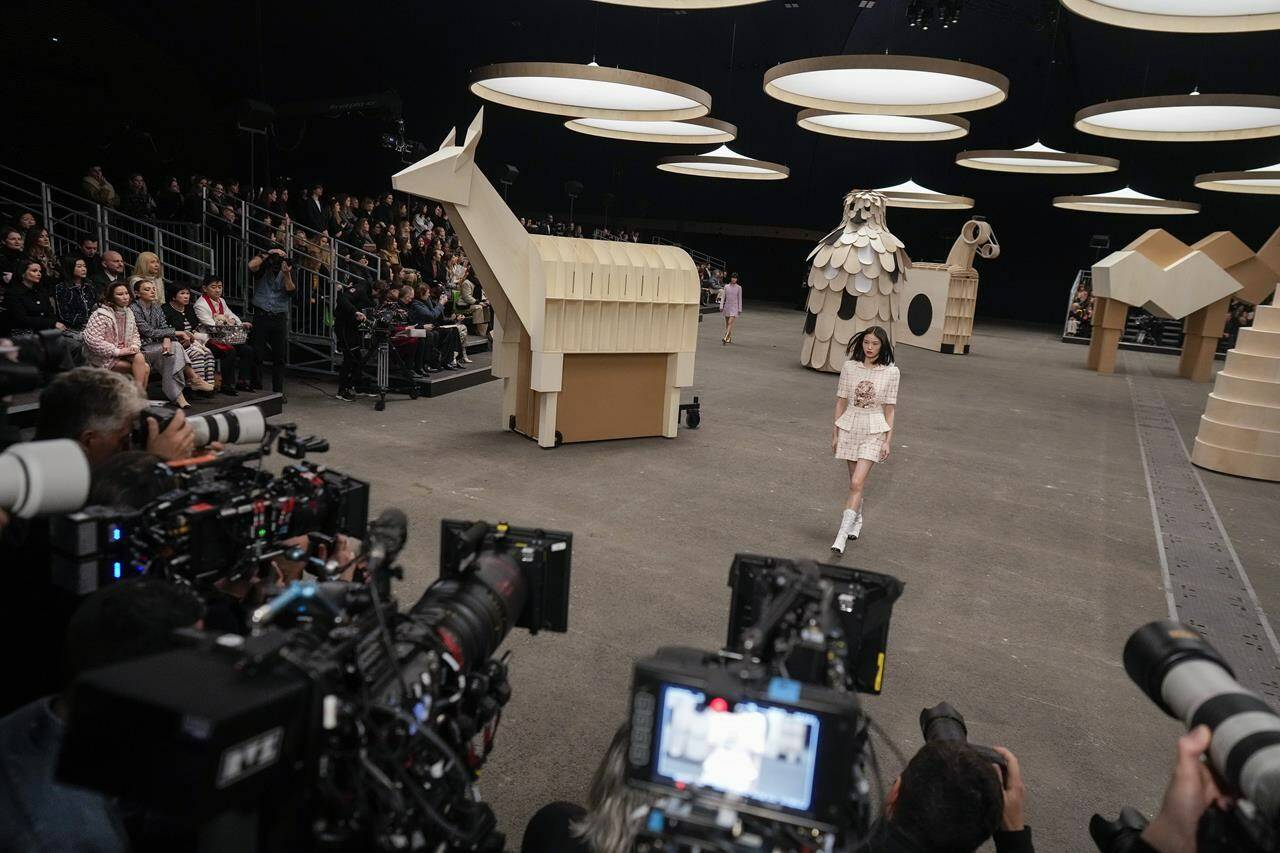Art returned to a glittering Chanel couture universe Tuesday with monumental animal sculptures gathering in the center of the runway-in-the-round like a surreal zoo for its Paris Fashion Week show.
Designer Virginie Viard collaborated with contemporary artist Xavier Veilhan who used a bestiary in house founder Coco Chanel’s apartment as a creative springboard for the carnival-like spring decor.
Yet as much as the animals — made of unpainted wood, paper and cardboard — appeared simplified, lifeless and monochrome, the Chanel collection contrasted strongly, sparkling with color and sequins in an unusually vibrant display.
Here are some highlights:
Chanel’s animal parade
Veilhan said he wanted to “evoke the relationship to animals which is constantly evolving in our societies.”
A VIP front row that included Marion Cotillard, Tilda Swinton, G-Dragon and Vanessa Paradis, watched on as a gargantuan camel, bull, fish, horse and lion resembling blown-up mobiles were wheeled onto this strange runway, beneath a ceiling installation of large geometric discs.
One bird pushed on set with a large beak and myriad scruffy wooden plumes seemed to give birth to a model in a top hat and a split white riding jacket with fringed skirt. It had guests reaching for their cameras — with one dubbing it the “Trojan chick.”
The rest of the collection seemed less directly connected to the animal theme — and this level of subtlety was not a bad thing. Coat dresses and bouclé tunics in tweed featured animal twists — such as embroideries of pet dog Labradors and Scotch Terriers. Elsewhere, there were strong equestrian styles, building on ideas from previous Viard seasons. Here, the riding jacket was key, constructed in gleaming silken tweeds above gamine miniskirts and youthful skorts.
There were quirks galore in the long white gloves, black and white bow ties and skintight gold- or black-capped boots with white boxer-like lace ups — yet they sometimes felt out of place.
The strength of this otherwise superlative and poetical couture — which sparkled throughout with brocade, paillettes, sequins and gleaming silks — spoke for itself.
One loose amorphous gown glistened like a silver fish with its thousands of embroidered sequins and black, white and gold silken breast. Elsewhere, a thickly textured bell skirt was constructed using rippling layers of white-colored silk like a underwater shell, or perhaps a delicate stratus cloud.
Armani Prive’s circus
At the grand stone entrance of the Garde Républicaine, Giorgio Armani’s late start forced guests — some scantily clad — to wait in the freezing evening cold. Once the green light was given, Michelle Yeoh was among the first to walk down the path of romantic lanterns — effusing that she was “very happy to be here.” Then came Carla Bruni-Sarkozy extolling the “feminist power of couture.”
Juliette Binoche was next, dodging questions about playing Coco Chanel in an upcoming Apple TV series “The New Look,” saying “this is not for tonight, now it’s time to support Giorgio — he’s a big supporter of artists.”
Once the media circus subsided, guests sat by a harlequin stage lined with interlocking-colored lozenges, ahead of a playful collection.
Silk bolero jackets opened the display that riffed on the 1980s, with lozenges appearing throughout — first as a 3D relief on jackets and, most dramatically, later on a blown-up courtly ruff.
Fastidious embroideries in every color under the sun dripped down sometimes slinky A-line and body-caressing column silhouettes.
But too many styles and shapes came together in this exhaustive collection — with its big jeweled flower appliques, dazzling sequin-encrusted jackets and round collar tops with geometric shapes — and that made the show hard to pin down as a whole.
Sometimes garments would have benefitted without Armani’s insistence on structure — such as one paneled gown that creased at the skirt — but there was so much dazzle and razzmatazz it’s unlikely many guests noticed.
Alexis Mabille’s color
His couture fusion dripped with drama.
French designer Alexis Mabille mixed old-school Grecian draping with a take on the Indian sari in the bright colors of South Asian dress. It produced a soft spring collection with longer silhouettes and fluttering scarves that used dozens of meters of floor-sweeping silk.
Bejeweled flowers adorned hairstyles, which, like the dangling lengths of fabric, flowed freely.
A bottle green gown cut a sublime hourglass silhouette. It reshaped the model’s body — open at the sides, wider at the top — and was held in place by a Grecian waistband. A cerulean blue gown, flowing unstructured from its round neck right to the floor, was notable for pure simplicity.
Not everything was a hit, though, such as a blue hooded gown with slightly incongruous, spiked satin lapels and a misplaced belt that confused the eye.
Stephane Rolland goes for glamour
A film projected on a giant screen to Stephane Rolland’s guests ahead of the show featured a homage to 1959 movie “Black Orpheus” filmed in Brazil. The movie, which won an Academy Award for Best Foreign Film, is set in the context of a favela during the famed Carnival time.
But Rolland seemed interested more in the carnival than the poverty of any favela — and the couture itself was highly stylized, haute glamour with a ballroom kick and, as ever, highly sculptural.
Purified white and black gowns sported giant whooshes of fabric, one as a floor-scraping train or as a huge neck band that when the model turned revealed a naked back. Another look, one of the collection’s best, was a three-dimensional back mini gown with skirt cut on the bias. It shot out in a huge wave from the hip.
Rolland played on the dramatic effect of flesh reveals against the purity of the often clean lengths of fabric — with scooped out plunging V-lines in the neck, split skirts and lopped-off shoulders.
Thomas Adamson, The Associated Press

